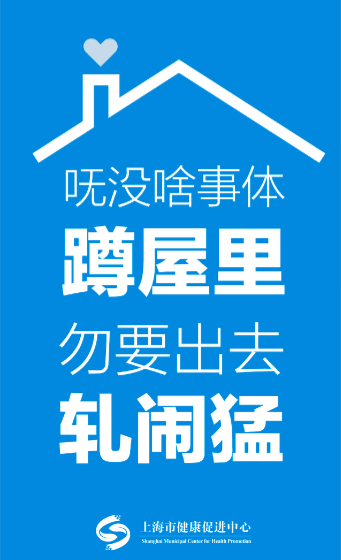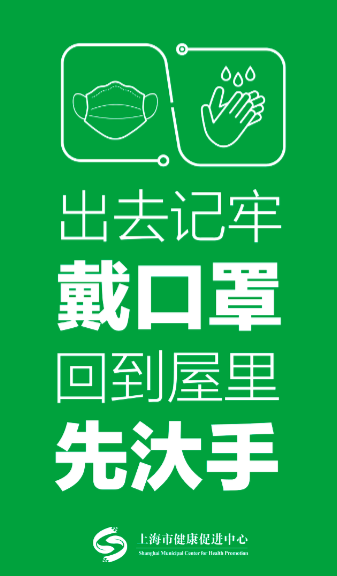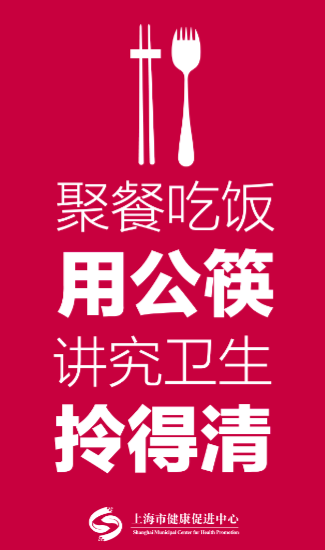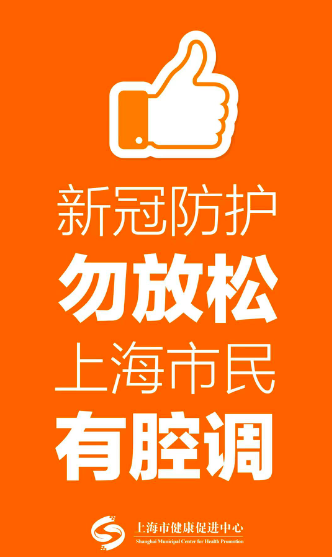Shanghainese posters
« previous post | next post »
From Diana Shuheng Zhang:
Romanization and translation by Richard VanNess Simmons:
呒没啥事体 m-meq sa zï-ti ‘It’s nothing, [simply]’
蹲屋里 dèn oq-li ’Stay at home’
勿要出去 veq-yaw tseq-chi ‘Don’t go out [and]’
轧闹猛 gaq naw-mã ‘Join the boisterous crowds (湊熱鬧)’
出去记牢 tseq-chi ji-law ‘[When] going out, remember well’
戴口罩 da keu-dzaw ‘To wear a mask’
回到屋里 h’uae-daw oq-li ‘[When] you go back home’
先汏手 shì d’a seu ‘Wash [your] hands first thing’
聚餐吃饭 zyü-tsòe chia-vae ‘[When] gathering for a meal and eating’
用公筷 y’ong gòng-kuae ‘Use serving chopsticks’
讲究卫生 jiã-jieu wae-sèn ‘Pay attention to cleanliness’
拎得清 lìn deq-chìn ‘Do what’s right’
新冠防护 shìn-guoe vãw-h’u ‘Coronavirus preventive measures’
勿放松 veq fãw-sòng ‘Should not be relaxed’
上海市民 Zãw-hae zï-min ‘Citizens of Shanghai’
有腔调 y’eu chiã̀-d’iaw ‘Uphold model behavior’
There is no official Romanization for Shanghainese. The Romanization given here is that of Professor Simmons himself. See his Shanghainese-English / English-S
Even though the posters are written in Sinographs (Hanzi, Chinese characters), there are many parts that are unintelligible to people who are literate in Mandarin but do not know Shanghainese. This has been confirmed to me by many non-Shanghainese speakers who can read texts written in Mandarin and even in Classical Chinese / Literary Sinitic. Two of the most difficult lines for me and my correspondents are the very first and the very last.
The last line is especially interesting linguistically, since in Mandarin qiāngdiào 腔调 means "accent; tune; intonation; tone of voice", but in Shanghainese it means "model behavior" and many other things, for which see this 20:21 video.
This phenomenon — the opacity of Sinographically written expressions across topolects — puts the lie to the widespread assertion that "Chinese 'dialects' are all the same when written down in characters". From numerous Language Log posts, we already know for sure this is not true for Cantonese, Taiwanese, and other Sinitic tongues. The current post demonstrates that it is also not true for Shanghainese.
Update (1/18/21)
Here is another version of the transcription and translation of the Shanghainese texts on the posters. It has been prepared by SHENG Yimin, Associate Professor, Department of Chinese Language and Literature, Fudan University. Courtesy of Rostislav Berezkin.
呒没啥事体蹲屋里
m¹¹məʔ³³ sa³⁴ zɿ¹¹tʰi³³ təŋ⁵³ uoʔ³³-li⁴⁴
no what matter stay home
‘If you don’t have special matters, please stay at home.’
勿要出去轧闹猛
vəʔ¹¹-iɔ³³ ʦʰəʔ³³ʨʰi⁴⁴ ɡaʔ²mɔ¹¹mã³³
don’t go.out join.in.the.fun
‘Don’t go to join in the fun.’
2
出门记牢戴口罩
ʦʰəʔ³³məŋ⁴⁴ ʨi³³lɔ⁴⁴ ta³⁴ kʰɤ³³ʦɔ⁴⁴
go.out remember wear mask
‘Don't forget to wear a mask when you go out.’
回到屋里先汏手
ue¹¹tɔ³³ uoʔ³³-li⁴⁴ ɕi⁵³ da¹³ sɤ³⁴
come.back home first wash hands
‘Wash your hands when you get home.’
3
聚餐吃饭用公筷
ʥy¹¹ʦʰø³³ ʨʰieʔ³³ve⁴⁴ ioŋ¹³ koŋ⁵⁵kʰua³¹
dine.together eat use public.chopsticks
‘Use the public chopsticks when dining together.’
讲究卫生拎得清
kã³³ʨiɤ⁴⁴ ue¹¹səŋ³³ liŋ⁵⁵-təʔ³¹-ʨʰiŋ¹¹
pay.attention.to hygiene have.a.clear.mind
‘Pay attention to hygiene.’
4
新冠防护勿放松
ɕiŋ⁵⁵kuø³¹ vã¹¹u³³ vəʔ³³-fã⁵⁵soŋ³¹
COVID-19 protect not-relax
‘Don’t relax protection against the COVID-19.’
上海市民有腔调
zã¹¹he³³ zɿ¹¹miŋ³³ iɤ¹³ʨʰiã⁵⁵diɔ³¹
Shanghai citizen be.super.cool
‘The Shanghainese are super cool.’
Selected readings
- "Writing Shanghainese " (5/25/16)
- "Shanghainese " (5/16/13)
- "A Potpourri of Materials on Shanghainese " (5/15/09)
- "Shanghainese vs. Mandarin " (4/19/09)
[Thanks to Jidong Yang and Wenkan Xu]




~flow said,
January 18, 2021 @ 2:46 am
回到屋里先汏手 is a great example how Chinese writing can work in the ideal case. It's much like when you have a general understanding of a text but don't know a single word you can fill out some gaps, as in "please XXXXXX your hands", only here the Mandarin reader that doesn't know Shanghainese gets three iconic droplets of water to speed the reading, "wash".
Chas Belov said,
January 18, 2021 @ 5:37 pm
Google Translate gives:
It's nothing
Squatting in the house
Don't go out and make a fuss
Remember to wear a mask when going out
Go back to the house first
Dinner party
Use chopsticks
Pay attention to hygiene
Can be clear
New crown protection do not relax
Shanghai citizens have an accent
Chas Belov said,
January 18, 2021 @ 5:40 pm
Do I correctly take the part about chopsticks to mean that everyone is supposed to use the serving chopsticks to move the food from the serving plate to the individual plate rather than one's own chopsticks? Of course, everyone is still touching the same chopsticks (hand germs) in place of the mouth germs potentially transmitted by serving one's self with one's own chopsticks.
I am not an epidemiologist and this is not medical advice.
David C. said,
January 18, 2021 @ 8:47 pm
@Chas Belov
That's right. Though widespread adoption of the practice of using serving chopsticks should help with stopping some of that transmission. It's something that has been commonly adopted across the richer parts of Asia – Japan, Taiwan, wealthy coastal cities in China, Singapore… Dipping individual chopsticks in communal hotpots has yet to be rooted out, however.
As an aside, this type of etiquette is so drilled into people during childhood that it can be a bit of a shock for many who grew up with a hygiene-conscious upbringing in Asia to visit or to move to the West, and find that no one bats an eyelid with the five-second rule, passing around a potato chip bag, or placing food on uncleaned surfaces (for instance, unwrapping a burger entirely, placing it on a fast food serving tray, then eating it with bare hands).
Rostislav said,
January 19, 2021 @ 2:14 am
About Simmons' Romanization: I wonder if tones are not indicated for Shanghainese?
Richard VN Simmons said,
January 25, 2021 @ 1:49 am
The phonology of tones in Shanghainese and their relationship to the pronunciation of initials and finals means that a Shanghainese Romanization actually only needs one tone mark: the one for the yīnpíng tone (corresponding to the first tone in Standard Chinese), which I mark with a grave diacritic (falling accent) over the main vowel of a syllable in that tone. One of the editor's of my dictionary, however, insisted that I use a couple of additional tone marks because there was a sense that readers are expecting them. But since the extras really are superfluous I left them out of the above rendering. When writing this note I discovered a typo, which I can also use to illustrate the point about the tones: The above Romanization of the word for 'eating' is mistakenly rendered "chia-vae." It should be 'chiq-vae'. With the superfluous tone marks, it is 'chīq-váe' in my dictionary. But anyone who has learned Shanghainese will actually know the tones in both syllables from the unmarked spelling 'chiq-vae', as well as how they should be pronounced together. On the other hand, the tone mark is required in the word for novel-coronavirus 'shìn-guoe' because the first syllable 新 needs to be distinguished from non-yīnpíng syllables with the same spelling, such as 'shin' 信 for 'letter'. In my dictionary 'letter' also gets a tone mark: 'shín'. But since there are only two possible tones for the spelling 'shin' only one mark is actually needed to make the distinction.